Joseph Shapiro
@joseph-s-shapiro.bsky.social
Econ prof: environmental/energy, trade, public, health econ.
Why it matters: 🌎⚖️
Designing optimal policies for externalities (smoking, innovation, pollution…) requires marginal costs and benefits, which are hard to estimate.
Offset markets help measure marginal policy costs, so can help design optimal policy.
7/7
Designing optimal policies for externalities (smoking, innovation, pollution…) requires marginal costs and benefits, which are hard to estimate.
Offset markets help measure marginal policy costs, so can help design optimal policy.
7/7
June 27, 2025 at 1:46 PM
Why it matters: 🌎⚖️
Designing optimal policies for externalities (smoking, innovation, pollution…) requires marginal costs and benefits, which are hard to estimate.
Offset markets help measure marginal policy costs, so can help design optimal policy.
7/7
Designing optimal policies for externalities (smoking, innovation, pollution…) requires marginal costs and benefits, which are hard to estimate.
Offset markets help measure marginal policy costs, so can help design optimal policy.
7/7
Robust findings: 🛠️📑
Other ways of aggregating offset price data give similar conclusions: marginal benefits of air pollution control ≫ marginal costs in most US regions
6/
Other ways of aggregating offset price data give similar conclusions: marginal benefits of air pollution control ≫ marginal costs in most US regions
6/
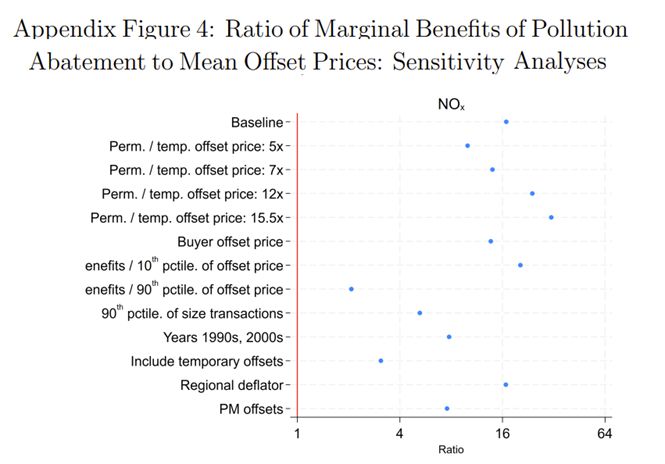
June 27, 2025 at 1:46 PM
Robust findings: 🛠️📑
Other ways of aggregating offset price data give similar conclusions: marginal benefits of air pollution control ≫ marginal costs in most US regions
6/
Other ways of aggregating offset price data give similar conclusions: marginal benefits of air pollution control ≫ marginal costs in most US regions
6/
Striking result: 🚨
Average benefit of NOₓ control > $40,000/ton Average cost <= $4,000/ton
That’s 10× gap. VOCs yield similar findings.
Some markets are more lenient than others:
5/
Average benefit of NOₓ control > $40,000/ton Average cost <= $4,000/ton
That’s 10× gap. VOCs yield similar findings.
Some markets are more lenient than others:
5/
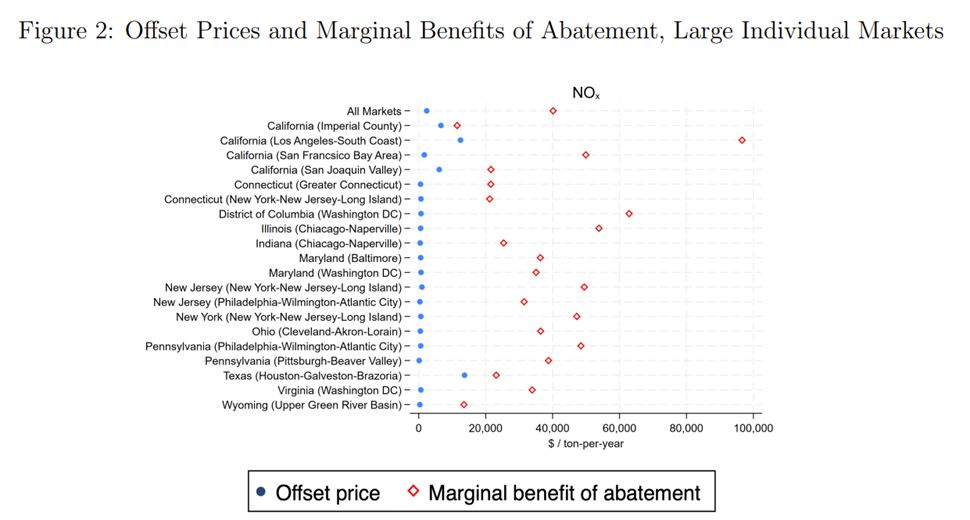
June 27, 2025 at 1:46 PM
Striking result: 🚨
Average benefit of NOₓ control > $40,000/ton Average cost <= $4,000/ton
That’s 10× gap. VOCs yield similar findings.
Some markets are more lenient than others:
5/
Average benefit of NOₓ control > $40,000/ton Average cost <= $4,000/ton
That’s 10× gap. VOCs yield similar findings.
Some markets are more lenient than others:
5/
Then we compare: 📈📉
We compare control costs estimated from pollution offsets against model-based health benefits (AP2, AP3, InMAP, EASIUR) to estimate the net gains from reducing pollution.
One input from AP3 model: marginal benefits of cutting NOₓ by location 🗺️ 👇
4/
We compare control costs estimated from pollution offsets against model-based health benefits (AP2, AP3, InMAP, EASIUR) to estimate the net gains from reducing pollution.
One input from AP3 model: marginal benefits of cutting NOₓ by location 🗺️ 👇
4/
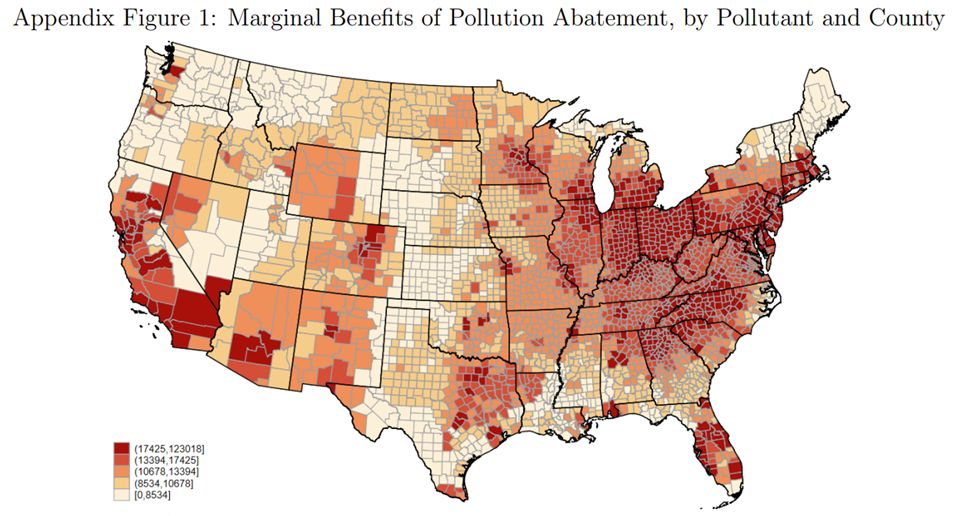
June 27, 2025 at 1:46 PM
Then we compare: 📈📉
We compare control costs estimated from pollution offsets against model-based health benefits (AP2, AP3, InMAP, EASIUR) to estimate the net gains from reducing pollution.
One input from AP3 model: marginal benefits of cutting NOₓ by location 🗺️ 👇
4/
We compare control costs estimated from pollution offsets against model-based health benefits (AP2, AP3, InMAP, EASIUR) to estimate the net gains from reducing pollution.
One input from AP3 model: marginal benefits of cutting NOₓ by location 🗺️ 👇
4/
How offsets work:⚖️
New factories in polluted cities must “offset” emissions by paying existing plants in same region to reduce pollutant.
On margin, firms should equate offset prices to marginal cost of pollution control 💵
ERC = emissions reduction credit = offset
3/
New factories in polluted cities must “offset” emissions by paying existing plants in same region to reduce pollutant.
On margin, firms should equate offset prices to marginal cost of pollution control 💵
ERC = emissions reduction credit = offset
3/
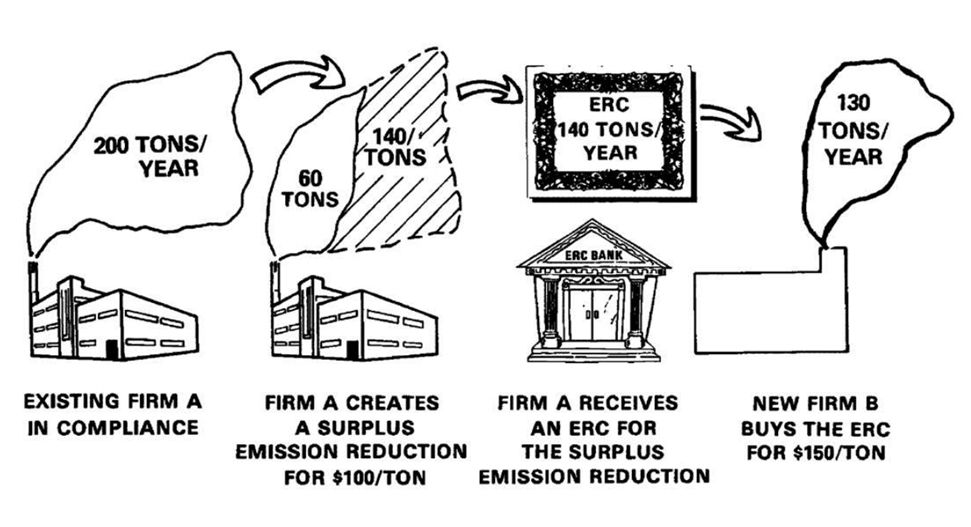
June 27, 2025 at 1:46 PM
How offsets work:⚖️
New factories in polluted cities must “offset” emissions by paying existing plants in same region to reduce pollutant.
On margin, firms should equate offset prices to marginal cost of pollution control 💵
ERC = emissions reduction credit = offset
3/
New factories in polluted cities must “offset” emissions by paying existing plants in same region to reduce pollutant.
On margin, firms should equate offset prices to marginal cost of pollution control 💵
ERC = emissions reduction credit = offset
3/
Approach: 🔍
We use prices from air pollution offset markets to estimate marginal costs of pollution control.
Each pollutant × region has own market.
100s of separate markets, distinct from cap-and-trade 🗺️📊
Example offset:
2/
We use prices from air pollution offset markets to estimate marginal costs of pollution control.
Each pollutant × region has own market.
100s of separate markets, distinct from cap-and-trade 🗺️📊
Example offset:
2/
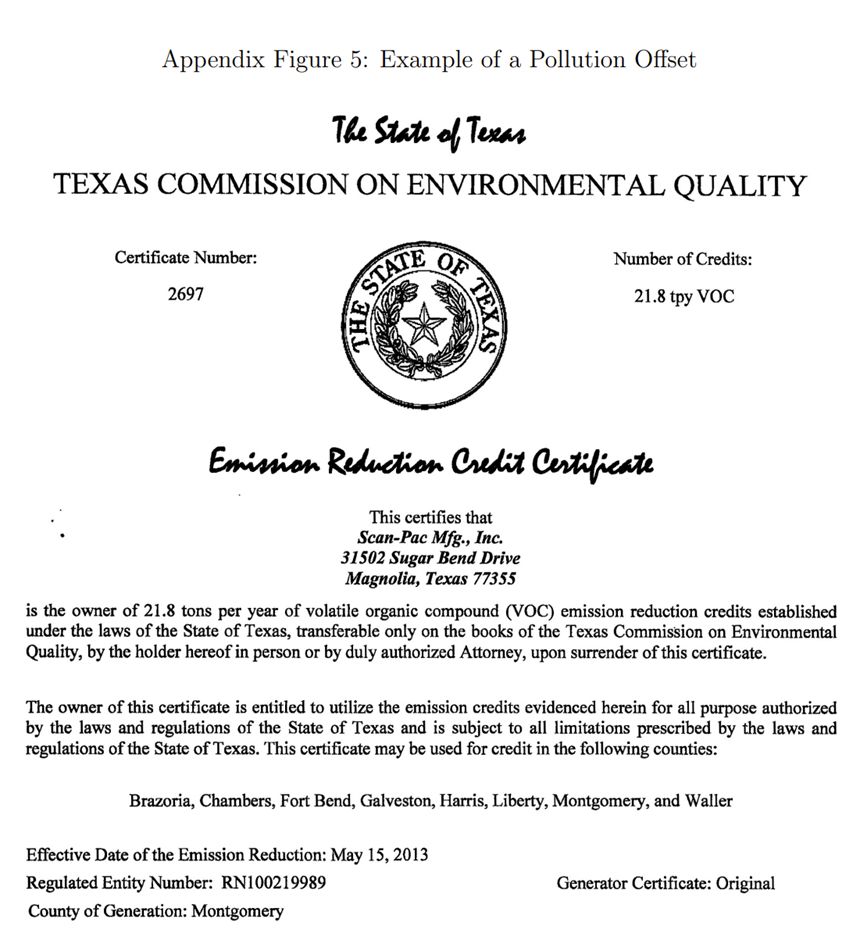
June 27, 2025 at 1:46 PM
Approach: 🔍
We use prices from air pollution offset markets to estimate marginal costs of pollution control.
Each pollutant × region has own market.
100s of separate markets, distinct from cap-and-trade 🗺️📊
Example offset:
2/
We use prices from air pollution offset markets to estimate marginal costs of pollution control.
Each pollutant × region has own market.
100s of separate markets, distinct from cap-and-trade 🗺️📊
Example offset:
2/
Striking result: 🚨
Average benefit of NOₓ control > $40,000/ton
Average cost <= $4,000/ton
That’s 10× gap. VOCs yield similar findings.
Some markets are more lenient than others:
5/
Average benefit of NOₓ control > $40,000/ton
Average cost <= $4,000/ton
That’s 10× gap. VOCs yield similar findings.
Some markets are more lenient than others:
5/

June 27, 2025 at 1:25 PM
Striking result: 🚨
Average benefit of NOₓ control > $40,000/ton
Average cost <= $4,000/ton
That’s 10× gap. VOCs yield similar findings.
Some markets are more lenient than others:
5/
Average benefit of NOₓ control > $40,000/ton
Average cost <= $4,000/ton
That’s 10× gap. VOCs yield similar findings.
Some markets are more lenient than others:
5/
Then we compare: 📈📉
We compare control costs estimated from pollution offsets against model-based health benefits (AP2, AP3, InMAP, EASIUR) to estimate the net gains from reducing pollution.
One input from AP3 model: marginal benefits of cutting NOₓ by location 🗺️ 👇
4/
We compare control costs estimated from pollution offsets against model-based health benefits (AP2, AP3, InMAP, EASIUR) to estimate the net gains from reducing pollution.
One input from AP3 model: marginal benefits of cutting NOₓ by location 🗺️ 👇
4/

June 27, 2025 at 1:25 PM
Then we compare: 📈📉
We compare control costs estimated from pollution offsets against model-based health benefits (AP2, AP3, InMAP, EASIUR) to estimate the net gains from reducing pollution.
One input from AP3 model: marginal benefits of cutting NOₓ by location 🗺️ 👇
4/
We compare control costs estimated from pollution offsets against model-based health benefits (AP2, AP3, InMAP, EASIUR) to estimate the net gains from reducing pollution.
One input from AP3 model: marginal benefits of cutting NOₓ by location 🗺️ 👇
4/
How offsets work:⚖️
New factories in polluted cities must “offset” emissions by paying existing plants in same region to reduce pollutant.
On margin, firms should equate offset prices to marginal cost of pollution control 💵
ERC = emissions reduction credit = offset
3/
New factories in polluted cities must “offset” emissions by paying existing plants in same region to reduce pollutant.
On margin, firms should equate offset prices to marginal cost of pollution control 💵
ERC = emissions reduction credit = offset
3/

June 27, 2025 at 1:25 PM
How offsets work:⚖️
New factories in polluted cities must “offset” emissions by paying existing plants in same region to reduce pollutant.
On margin, firms should equate offset prices to marginal cost of pollution control 💵
ERC = emissions reduction credit = offset
3/
New factories in polluted cities must “offset” emissions by paying existing plants in same region to reduce pollutant.
On margin, firms should equate offset prices to marginal cost of pollution control 💵
ERC = emissions reduction credit = offset
3/
Approach: 🔍
We use prices from air pollution offset markets to estimate marginal costs of pollution control.
Each pollutant × region has own market. 100s of separate markets, distinct from cap-and-trade 🗺️📊
Example offset:
2/
We use prices from air pollution offset markets to estimate marginal costs of pollution control.
Each pollutant × region has own market. 100s of separate markets, distinct from cap-and-trade 🗺️📊
Example offset:
2/

June 27, 2025 at 1:25 PM
Approach: 🔍
We use prices from air pollution offset markets to estimate marginal costs of pollution control.
Each pollutant × region has own market. 100s of separate markets, distinct from cap-and-trade 🗺️📊
Example offset:
2/
We use prices from air pollution offset markets to estimate marginal costs of pollution control.
Each pollutant × region has own market. 100s of separate markets, distinct from cap-and-trade 🗺️📊
Example offset:
2/
Great! Hope you/students find it useful. Slides are online in case they are helpful joseph-s-shapiro.com/research/SEE...
joseph-s-shapiro.com
January 28, 2025 at 4:45 AM
Great! Hope you/students find it useful. Slides are online in case they are helpful joseph-s-shapiro.com/research/SEE...
I think of spatial autocorrelation as a general issue, not specific to environment. Re:publication outlets, this is always a relevant question but we are squeezed for space and I find it challenging to give general advice on this kind of question without knowing the specific context.
January 28, 2025 at 4:44 AM
I think of spatial autocorrelation as a general issue, not specific to environment. Re:publication outlets, this is always a relevant question but we are squeezed for space and I find it challenging to give general advice on this kind of question without knowing the specific context.
Thanks Ariel! Re:unobservables/uncertainty, what did you have in mind? We talk about some spatial research designs and place-based environmental policies. As to spatial inference, we try to focus on spatial issues particular to the environment or environmental issues specific to spatial settings...
January 28, 2025 at 4:44 AM
Thanks Ariel! Re:unobservables/uncertainty, what did you have in mind? We talk about some spatial research designs and place-based environmental policies. As to spatial inference, we try to focus on spatial issues particular to the environment or environmental issues specific to spatial settings...

